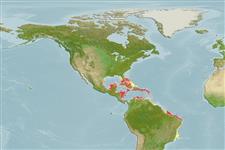Common names from other countries
Environment: milieu / climate zone / depth range / distribution range
Ecologie
marien rifbewoner; diepte 5 - 20 m (Ref. 9710). Tropical
Western Central Atlantic: Florida (USA), Bahamas, Puerto Rico, Grand Cayman Island, Virgin Islands, Antigua, Barbados, Aruba, Curaçao, Colombia, and Venezuela.
Grootte / Gewicht / Leeftijd
Maturity: Lm ? range ? - ? cm
Max length : 8.5 cm TL mannelijk / geslacht onbekend; (Ref. 7251)
Dorsale stekels (totaal) : 18 - 21; Dorsale zachte stralen (totaal) : 31 - 36; Anale stekels: 2; Anale zachte stralen: 33 - 37. Light brown with pale dots and a narrow mid-lateral brown stripe, sometimes broken into blotches; faint bars on body; small black spot at front of dorsal fin; mature males with more yellow on head, gill membranes black; branchiostegal rays blue (Ref. 13442).
Occurs in groups, one to a hole, in limestone or coral rubble in clear water. Feeds on small crustaceans, worms, and fishes (Ref. 5521).
Levenscyclus en paargedrag
Maturities | Voortplanting | Spawnings | Egg(s) | Fecundities | Larven
Robins, C.R. and G.C. Ray, 1986. A field guide to Atlantic coast fishes of North America. Houghton Mifflin Company, Boston, U.S.A. 354 p. (Ref. 7251)
Status op de Rode Lijst van het IUCN (Ref. 130435)
CITES (Ref. 128078)
Not Evaluated
Gevaar voor de mens
Harmless
Gebruik door de mens
Visserij: commercieel; Aquarium: Commercieel
Tools
Speciale rapporten
Download XML
Internetbronnen
Estimates based on models
Preferred temperature (Ref.
115969): 26.4 - 28.2, mean 27.5 (based on 520 cells).
Fylogenetische diversiteitsindex (Ref.
82804): PD
50 = 0.5010 [Uniqueness, from 0.5 = low to 2.0 = high].
Bayesian length-weight: a=0.00457 (0.00183 - 0.01143), b=3.08 (2.86 - 3.30), in cm Total Length, based on LWR estimates for this (Sub)family-body shape (Ref.
93245).
Trofisch niveau (Ref.
69278): 3.7 ±0.55 se; based on food items.
Fishing Vulnerability (Ref.
59153): Low vulnerability (10 of 100).
